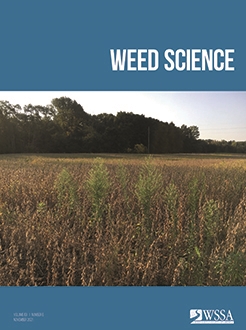On-site surveys of weed populations provide information on the relative occurrence and density of weeds that can be useful to growers in that region. Data generated by weed surveys can aid in the management of weed issues by monitoring the movement of problem weeds and forecasting areas susceptible to infestations. Currently, on-site surveys are often performed on a small scale, within single fields or counties. Questionnaire surveys are helpful for assessing relative abundance but do not always provide detailed information on weed distribution in time or space. A survey was conducted annually in Ohio from 2013 through 2017 in 49 counties with soybean [Glycine max (L.) Merr.] production to assess the late-season occurrence of horseweed [Conyza canadensis (L.) Cronquist]. The objectives of this research were to: (1) determine the frequency, level of infestation, and distribution of C. canadensis in soybean fields in the primary soybean-producing Ohio counties over 5 yr; and (2) identify significant spatial clusters or movement trends over time. Conyza canadensis was encountered in each county from 2013 through 2017. Spatial cores of interest, or counties identified as having significant levels of C. canadensis infestations or a lack thereof relative to surrounding counties, were identified in all years except 2017. The lowest frequency of C. canadensis encountered at all rating levels occurred in 2017, which coincided with second-highest frequency of infestations (highest density level) among years. There was no distinct distribution or pattern of C. canadensis movement within the state from year to year, but there was an increase in counties with infestations over time compared with the early years of the survey when many counties had few to no infestations. These results suggest that C. canadensis persists as a common and troublesome threat to Ohio soybean producers and that growers should continue making C. canadensis management a priority when developing weed control programs.
How to translate text using browser tools
28 June 2021
A Survey Evaluating the Spatial and Temporal Distribution of Horseweed (Conyza canadensis) Late Season in Ohio Soybean Fields from 2013 to 2017
Alyssa I. Essman,
Mark M. Loux,
Alexander J. Lindsey,
Bruce A. Ackley,
Emilie E. Regnier
ACCESS THE FULL ARTICLE

Weed Science
Vol. 69 • No. 6
November 2021
Vol. 69 • No. 6
November 2021
Erigeron canadensis
Marestail
weed management





